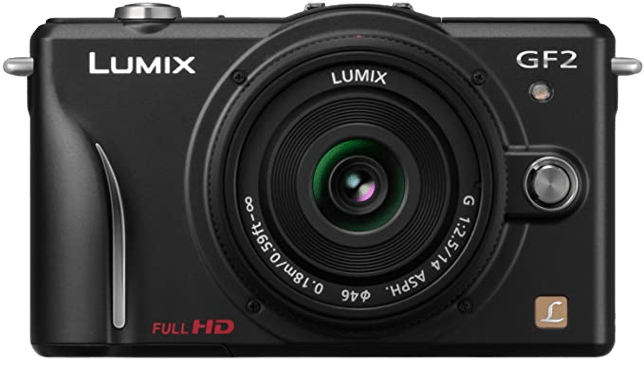Panasonic Lumix DMC GF2 Specs and Scores

The Panasonic Lumix DMC GF2 receives a score of 40/100. Announced on November 4th, 2010, this mirrorless camera was initially priced at $599. With dimensions of 113 x 68 x 33mm and a weight of 310g (0.68lbs), it is a compact and lightweight option for photographers. Although it was a decent camera in 2010, its specifications and capabilities may not be as impressive in today’s market, considering the rapid advancements in camera technology. Nonetheless, it remains a functional choice for casual photography enthusiasts.
Panasonic Lumix DMC GF2 Overview and Optics
The optics of the Panasonic Lumix DMC GF2 receive a score of 39/100. This camera features 12.1 megapixels, a shooting speed of 2.6, a CMOS sensor type, and a Venus Engine FHD processor. The DXOMARK score for the sensor is 54, and the sensor size is Micro Four Thirds. The lens mount is Micro 4/3, but the camera lacks image stabilization and has an aspect ratio of 4:3.
Compared to other cameras on the market, the GF2 has lower specifications in terms of megapixels, shooting speed, and sensor performance. The lack of image stabilization may also be a disadvantage for some users. However, the Micro Four Thirds sensor size and lens mount offer compatibility with a wide range of lenses, providing versatility for different photography styles.
Taking these factors into account, the Panasonic Lumix DMC GF2’s optics may not be the strongest option for those seeking the latest technology and highest performance. However, it remains a viable choice for users who prioritize lens compatibility and versatility in their camera selection.
Panasonic Lumix DMC GF2 Video Performance
The Panasonic Lumix DMC GF2 receives a video score of 56/100. This camera has a maximum video resolution of Full HD, with dimensions of 1920 x 1080 pixels. It also offers a maximum video frame rate of 60fps. However, the camera lacks built-in time-lapse functionality.
Considering today’s market, the Full HD resolution and 60fps frame rate are adequate for casual users but may fall short for professionals or enthusiasts seeking higher resolutions or smoother frame rates. Many modern cameras now offer 4K resolution and higher frame rates, surpassing the video capabilities of the Lumix DMC GF2.
The Lumix DMC GF2’s video capabilities are suitable for everyday use but may not meet the needs of those seeking advanced video features. Its score of 56/100 reflects the camera’s limitations in a competitive market.
Panasonic Lumix DMC GF2 Features and Benefits
The Panasonic Lumix DMC GF2 receives a feature score of 49/100. This score reflects the camera’s specifications and how they compare to other models on the market. The camera has a screen size of 3 inches, with a resolution of 460,000 dots. The screen is a touchscreen, which allows for easy navigation and control.
However, the GF2 lacks a flip screen, GPS, WIFI, and Bluetooth capabilities. These missing features may put the camera at a disadvantage compared to other models with more advanced technology. The absence of a flip screen limits the camera’s versatility, while the lack of GPS, WIFI, and Bluetooth means that users cannot easily share or transfer photos and videos.
Despite these limitations, the Panasonic Lumix DMC GF2 is a solid camera for those looking for a simple, easy-to-use option. Its touchscreen and decent screen resolution make it a suitable choice for basic photography needs. However, for users seeking advanced features and connectivity options, other models may be more suitable.
Panasonic Lumix DMC GF2 Storage and Battery
The Panasonic Lumix DMC GF2 receives a storage and battery score of 16/100. This camera has one memory card slot, which accepts SD, SDHC, and SDXC cards. In the current market, this is a common and widely compatible storage option. However, the camera’s battery life is limited to 300 shots per charge, powered by a DMW-BLD10 battery. Additionally, the GF2 does not support USB charging.
Considering these specifications, the camera’s storage and battery capabilities are not exceptional when compared to other modern cameras. Although the memory card compatibility is standard, the battery life and lack of USB charging may be limiting factors for users seeking extended usage and flexibility.
